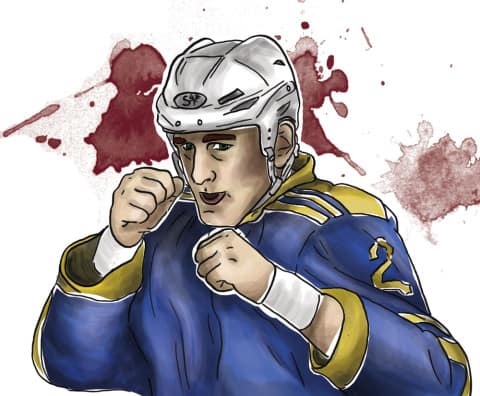KADE GATES
 When it comes to fighting in the National Hockey League, those who are against it need to take a step back and see banning it will not have the desired effect. If you want to cut down on concussions, eliminating fighting from the sport isn’t the way to go.
When it comes to fighting in the National Hockey League, those who are against it need to take a step back and see banning it will not have the desired effect. If you want to cut down on concussions, eliminating fighting from the sport isn’t the way to go.
“It’s part of the game, it always has [been] and I think it always will be,” Ottawa Senators forward Chris Neil said in a CBC article. In one sentence, Neil summarized the views of 98 per cent of the NHL players per a 2011 poll done by the NHL Players’ Association and CBC’s Hockey Night in Canada.
The Toronto Star reported Buffalo Sabres captain Steve Ott voicing his opinion on fighting with, “I hate that it’s even being talked about.” A more recent poll done by Angus Reid suggests that roughly two thirds of Canadian hockey fans support the banning of fighting in hockey at all levels, including professional. There are many arguments against fighting in hockey but this is about the pros to keeping fighting in the game.
“Stick work” is an overarching term for slashing, hooking and cross-checking infractions. Over the last five to 10 years, stick work has become increasingly prevalent in the hockey world as the rules against fighting have carried more supplementary discipline.
The Chris Simon incident would be a perfect example of how fighting can be a better alternative to using your stick. In March 2007, Simon was playing for the New York Islanders as they went up against the New York Rangers. Late in the third, Rangers forward Ryan Hollweg checked Simon into the boards. Then as play continued, Simon got in front of Hollweg and took a two-handed baseball swing with his stick, colliding with Hollweg’s chin which resulted in stitches for Hollweg. Simon was handed a 30-game suspension, the longest in NHL history.
Now by no means is fighting safe, but as with most sports there are health risks. Concussions are the real sticking point here as most professional, non-fighting supporters believe that eliminating fighting will stop the trend of concussions going on in the NHL. Unfortunately for fighting, it only appears in the media when something bad happens.
To start off last season, the Toronto Maple Leafs and Montreal Canadiens faced off in a season opener where Colton Orr and George Parros got into a fight. Parros slipped at the end of the fight and fell face first into the ice receiving a concussion.
Most players around the league, including Jared Boll called the incident “an anomaly.” Boll went on to say: “There are not many concussions if you watch fighting. I think it’s the easiest target that people go after: get fighting out of the game and it’ll solve everything.”
If concussions are what people want eliminated from the game, it comes down to teaching kids how to properly hit and teaching coaches to encourage clean hitting and not targeting players known to be in dangerous positions. Anaheim Ducks coach Bruce Boudreau called fighting more for protection. In baseball, pitchers throw at batters, if things get out of hand, usually resolving the issue with nothing but a couple of bruises. In hockey, would you rather some bruised knuckles and fat lips, or broken bones and scarred faces?
—
Graphic: Stephanie Mah/Graphics Editor